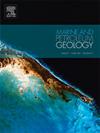扬子地台西北部中上寒武统碳同位素地层学:全球对比意义
IF 3.6
2区 地球科学
Q1 GEOSCIENCES, MULTIDISCIPLINARY
引用次数: 0
摘要
阶梯式正碳同位素偏移(SPICE)和德鲁姆期碳同位素偏移(DICE)是中晚寒武世沉积记录中的主要事件,但它们的量级以及局部和全球相关性都存在争议。本文介绍了中国扬子地台西北部中-上寒武统后滩剖面和七辽剖面的两个高分辨率δ13Ccarb剖面。两个剖面所研究的西乡池组主要由厚层状泥晶碳酸盐(白云岩)与鲕粒粒岩层交替构成。多种技术筛选证实了所调查泥晶碳酸盐的岩石学和地球化学保存。高温剖面δ13C值均值为−0.2‰,标准差为1.0‰(−1.9‰~ 3.1‰),δ18O值为−9.9‰±1.1‰(−13.9‰~−7.8‰)。QL部分中,δ13 c值−0.4‰±1.3‰(−2.5‰- -3.3‰)和δ18 o值−9.9‰±1.5‰(12‰−−5.9‰)。同样,高温切片中Mn含量为110±89 ppm (46-524 ppm), Sr含量为72±32 ppm (34-162 ppm),而QL切片中Mn含量为96±51 ppm (35-282 ppm), Sr含量为290±150 ppm (75-662 ppm)。δ13C和δ18O值在两个剖面上的相关性不显著(HT: R2 = 0.1;Ql: r2 = 0.1)。同样,δ13C值与其Mn/Sr比值的相关性也不显著(HT: R2 = 0.2;Ql: r2 = 0.1)。这些弱相关性表明,δ13C特征受成岩作用的影响最小,至少保持了它们的近原生状态。这种保存使得δ13C值可以用于构建高分辨率剖面和可靠的全球相关性,尽管缺乏强大的局部关系。高温剖面中较低的负偏移与全球DICE和pre-SPICE事件相关,而较高的正偏移与SPICE事件相匹配。QL部分的中间负偏移和上部正偏移分别与pre-SPICE和SPICE事件对齐。本研究的发现有望通过提供华南地区高分辨率δ13C剖面,增强对DICE、pre-SPICE和SPICE事件的理解。这些结果改善了扬子地台内的区域地层对比,有助于建立更可靠的全球年代地层格架。本文章由计算机程序翻译,如有差异,请以英文原文为准。
Carbon-isotope stratigraphy of the Middle–Upper Cambrian in northwestern Yangtze Platform, China: Implications for global correlations
The Steptoean Positive Carbon Isotope Excursion (SPICE) and the Drumian Carbon Isotope Excursion (DICE) are major events in the Middle‒Late Cambrian sedimentary records, but controversially heterogeneous in their magnitudes, as well as local and global correlations. This paper presents two high-resolution δ13Ccarb profiles from the Houtan (HT) and Qiliao (QL) sections in the northwestern Yangtze Platform (China) that span the Middle-Upper Cambrian. The investigated Xixiangchi Formation in both sections predominantly consists of thick-bedded micritic carbonates (dolomicrite) alternating with oolitic grainstone beds. A multi-technique screening proved the petrographic and geochemical preservation of the investigated micritic carbonates. In the HT section, the δ13C values were characterized by a mean of −0.2 ‰ and a standard deviation of 1.0 ‰ (−1.9 ‰–3.1 ‰), while the δ18O values were −9.9 ‰ ± 1.1 ‰ (−13.9 ‰ to −7.8 ‰). In the QL section, the δ13C values were −0.4 ‰ ± 1.3 ‰ (−2.5 ‰–3.3 ‰) and the δ18O values were −9.9 ‰ ± 1.5 ‰ (−12 ‰ to −5.9 ‰). Similarly, Mn contents in the HT section were 110 ± 89 ppm (46–524 ppm) and Sr contents were 72 ± 32 ppm (34–162 ppm), whereas in the QL section, Mn contents were 96 ± 51 ppm (35–282 ppm) and Sr contents were 290 ± 150 ppm (75–662 ppm). The δ13C and δ18O values exhibited insignificant correlations in both sections (HT: R2 = 0.1; QL: R2 = 0.1). Similarly, the δ13C values also show an insignificant correlation with their Mn/Sr ratio (HT: R2 = 0.2; QL: R2 = 0.1). These weak correlations suggest that the δ13C signatures are minimally affected by diagenetic processes, preserving at least their near-primary state. This preservation allows the δ13C values to be used for constructing high-resolution profiles and reliable global correlations, despite the lack of strong local relationships. The lower negative excursions in the HT section correlate with the global DICE and pre-SPICE events, while the upper positive excursion matches the SPICE. The middle negative and upper positive excursions in the QL section align with the pre-SPICE and the SPICE events, respectively. The findings of the current work are expected to enhance the understanding of DICE, pre-SPICE, and SPICE events by providing high-resolution δ13C profiles from South China. These results improve regional stratigraphic correlations within the Yangtze Platform and contribute to more reliable global chronostratigraphic frameworks.
求助全文
通过发布文献求助,成功后即可免费获取论文全文。
去求助
来源期刊

Marine and Petroleum Geology
地学-地球科学综合
CiteScore
8.80
自引率
14.30%
发文量
475
审稿时长
63 days
期刊介绍:
Marine and Petroleum Geology is the pre-eminent international forum for the exchange of multidisciplinary concepts, interpretations and techniques for all concerned with marine and petroleum geology in industry, government and academia. Rapid bimonthly publication allows early communications of papers or short communications to the geoscience community.
Marine and Petroleum Geology is essential reading for geologists, geophysicists and explorationists in industry, government and academia working in the following areas: marine geology; basin analysis and evaluation; organic geochemistry; reserve/resource estimation; seismic stratigraphy; thermal models of basic evolution; sedimentary geology; continental margins; geophysical interpretation; structural geology/tectonics; formation evaluation techniques; well logging.
 求助内容:
求助内容: 应助结果提醒方式:
应助结果提醒方式:


